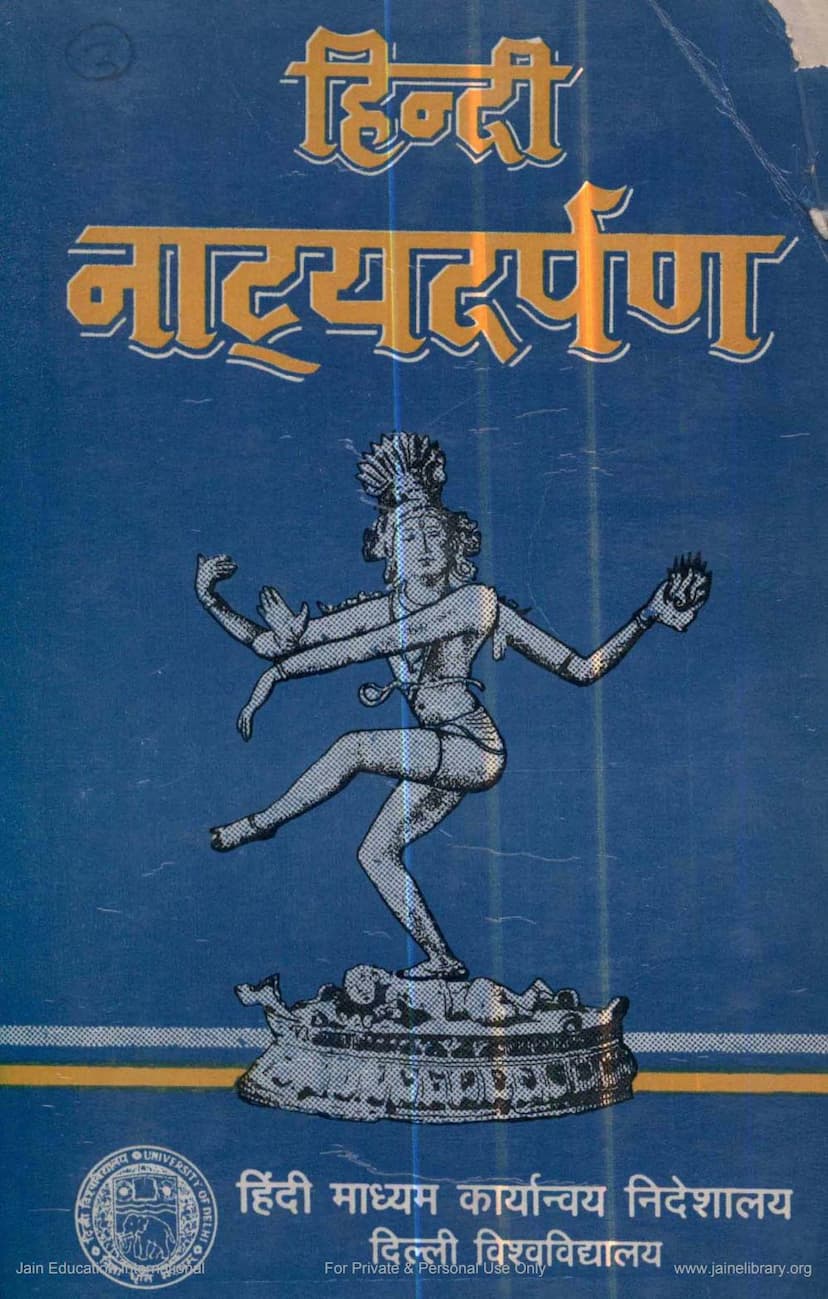Natyadarpan Hindi
Added to library: September 2, 2025

Summary
नाट्यदर्पण (Natya Darpan) - A Comprehensive Summary
Title: नाट्यदर्पण (Natya Darpan) Authors: Ramchandra Gunchandra, Dashrath Oza, Satyadev Chaudhary Publisher: Hindi Madhyam Karyanvay Nideshalay, Delhi Catalog Link: https://jainqq.org/explore/001892/1
Overview:
The "Natya Darpan" is a seminal work in Sanskrit dramaturgy, presented here in a Hindi translation. It is attributed to the Jain scholars Ramchandra and Gunchandra, who were disciples of the renowned Acharya Hemachandra. This book serves as a detailed commentary and interpretation of the dramatic theories and principles outlined in earlier works, primarily Bharata Muni's "Natyashastra," while also presenting original insights and critiques. The Hindi translation by the Hindi Directorate of Delhi University, under the chief editorship of Dr. Nagendra, aims to make this significant text accessible to a wider audience.
Core Content:
The "Natya Darpan" is structured into four "Vivekas" (sections), each delving into crucial aspects of dramaturgy:
-
Pratham Vivek (First Section): Nataka (Play) and Other Forms of Drama: This section focuses on the fundamental principles of drama, particularly the "Nataka" genre. It elaborates on its characteristics, including:
- Dramatis Personae: Defining the nature and classification of characters, including the protagonist (Nayak) and their various types (Dhira-Udatta, Dhira-Lalit, etc.), and the heroine (Nayika).
- Plot Structure: Detailing the concept of "Artha Prakriti" (elements of the plot) like Beeja (seed), Bindu (thread), Pataka (flag), Prakri, and Karya (result). It also elaborates on the five "Sandhis" (unions) that structure a play: Mukha (beginning), Pratimukha (development), Garbha (middle), Vimarsha (turning point), and Nirvahana (conclusion). The "sandhi-angas" (limbs of the unions) are meticulously described.
- Characterization: Discussing the types of heroes and heroines, their classifications based on temperament and disposition.
- Sentiments and Emotions (Rasa and Bhava): Providing an analysis of the "Nava Rasas" (nine sentiments) and "Vyabhichari Bhavas" (transient emotions) that contribute to the aesthetic experience of the audience.
- Performance Elements: Touching upon aspects of acting (Abhinaya), including Vachika (verbal), Angika (gestural), Sattvika (emotional), and Aharya (costume/makeup).
- Other Dramatic Forms: While focusing on Nataka, the text also outlines the characteristics of other ten types of Sanskrit dramas like Prakarana, Vyayoga, Samavakara, Bhaana, Prahasana, Dima, Ehamriga, Veethi, and Utkrishthikaanka, and discusses their unique features and variations.
-
Dwitiya Vivek (Second Section): Other Forms of Drama (Remaining Eleven): This section continues the discussion of various dramatic forms, detailing the specific characteristics of Prakarana, Vithi, and other related genres, further enriching the understanding of dramatic classification.
-
Tritiya Vivek (Third Section): Vrittis, Rasa, Bhava, and Abhinaya: This section delves into the performative and aesthetic aspects of drama:
- Vrittis: Explaining the four dramatic styles or "Vrittis" – Bharati (Sanskrit-based, often intellectual), Sattvati (representing valor and seriousness), Kaishiki (graceful, associated with love and humor), and Arambhatee (vigorous, associated with action and anger).
- Rasa: A detailed exploration of the nine sentiments (Nava Rasas) – Shringara (love), Hasya (humor), Karuna (pathos), Raudra (anger), Veera (heroism), Bhayanaka (terror), Bibhatsa (disgust), Adbhuta (wonder), and Shanta (peace). It also discusses the concept of "Bhava" (emotion) and their role in evoking Rasa.
- Abhinaya: Analyzing the different types of acting and expression that bring the characters and emotions to life on stage.
-
Chaturtha Vivek (Fourth Section): Ancillary Elements and Refutations: This section covers miscellaneous but essential elements of dramaturgy, including discussions on the "Nandi" (auspicious invocation), "Dhruva" (musical interludes), and also importantly, refutations of the opinions of other scholars, demonstrating the authors' critical engagement with the field.
Key Contributions and Originality:
The "Natya Darpan" is recognized for several significant contributions to dramaturgy:
- Elaboration and Systematization: While based on Bharata's Natyashastra, Ramchandra and Gunchandra elaborate on many concepts, providing more detailed explanations and a systematic approach to dramatic elements.
- Original Insights and Critiques: The authors do not merely reiterate existing theories but also express their own views, often differing from Bharata Muni and other predecessors like Dhananjaya in "Dasharupaka." They present original arguments and classifications.
- Emphasis on Rasa: The "Natya Darpan" places a strong emphasis on the importance of "Rasa" (aesthetic sentiment) as the lifeblood of drama, arguing that even if other elements are present, the absence of Rasa renders a play lifeless.
- Classification of Rupakas: While Bharata enumerates ten types of Rupakas, Ramchandra and Gunchandra expand this to twelve, including "Nattika" and "Prakarani" in their classification.
- Inclusion of Jain Context: As Jain scholars, their work subtly reflects Jain philosophical underpinnings, particularly in their approach to concepts like "Jaini Vani" (Jain speech) and its connection to auspicious beginnings and ethical conduct.
- Practical Examples: The text is rich with examples drawn from various classical Sanskrit dramas, including plays by Kalidasa, Bhavabhuti, and even their own compositions, which helps in understanding the theoretical concepts.
Authors and Publisher:
The Hindi translation is a testament to the collaborative effort of prominent scholars in Hindi literature. The original work is attributed to Ramchandra and Gunchandra. The Hindi Madhyam Karyanvay Nideshalay of Delhi University published this edition, with Dr. Nagendra as the chief editor, supported by a distinguished editorial board.
Significance:
The "Natya Darpan" is a vital resource for understanding the evolution of Sanskrit dramaturgy. It reflects the intellectual climate of its time, showcasing a blend of adherence to tradition and innovative thinking. The Hindi translation makes this complex and significant text accessible to a broader audience interested in Indian classical arts and literature.